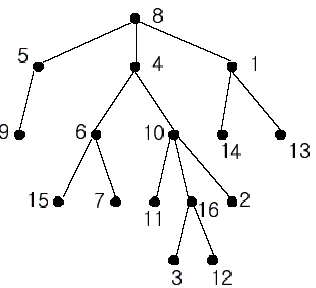poj 1330 Nearest Common Ancestors 求最近祖先节点
Nearest Common Ancestors
| Time Limit: 1000MS | Memory Limit: 10000K | |
| Total Submissions: 37386 | Accepted: 18694 |
Description

In the figure, each node is labeled with an integer from {1,
2,...,16}. Node 8 is the root of the tree. Node x is an ancestor of node
y if node x is in the path between the root and node y. For example,
node 4 is an ancestor of node 16. Node 10 is also an ancestor of node
16. As a matter of fact, nodes 8, 4, 10, and 16 are the ancestors of
node 16. Remember that a node is an ancestor of itself. Nodes 8, 4, 6,
and 7 are the ancestors of node 7. A node x is called a common ancestor
of two different nodes y and z if node x is an ancestor of node y and an
ancestor of node z. Thus, nodes 8 and 4 are the common ancestors of
nodes 16 and 7. A node x is called the nearest common ancestor of nodes y
and z if x is a common ancestor of y and z and nearest to y and z among
their common ancestors. Hence, the nearest common ancestor of nodes 16
and 7 is node 4. Node 4 is nearer to nodes 16 and 7 than node 8 is.
For other examples, the nearest common ancestor of nodes 2 and 3 is
node 10, the nearest common ancestor of nodes 6 and 13 is node 8, and
the nearest common ancestor of nodes 4 and 12 is node 4. In the last
example, if y is an ancestor of z, then the nearest common ancestor of y
and z is y.
Write a program that finds the nearest common ancestor of two distinct nodes in a tree.
Input
input consists of T test cases. The number of test cases (T) is given in
the first line of the input file. Each test case starts with a line
containing an integer N , the number of nodes in a tree,
2<=N<=10,000. The nodes are labeled with integers 1, 2,..., N.
Each of the next N -1 lines contains a pair of integers that represent
an edge --the first integer is the parent node of the second integer.
Note that a tree with N nodes has exactly N - 1 edges. The last line of
each test case contains two distinct integers whose nearest common
ancestor is to be computed.
Output
Sample Input
2
16
1 14
8 5
10 16
5 9
4 6
8 4
4 10
1 13
6 15
10 11
6 7
10 2
16 3
8 1
16 12
16 7
5
2 3
3 4
3 1
1 5
3 5
Sample Output
4
3
题意:输入t代表有多个测试样例,每个样例第一行输入一个数n,表示有n个节点,接下来n-1行描述这n个节点的关系,第n行输入x,y要求x,y的最近公共祖先
#include <iostream>
#include <cstdio>
#include <cstring>
#include <vector>
using namespace std;
const int N = 1e4 + ;
vector<int> ve[N];//ve[]是用来建表的一个数组
vector<int> que[N];//que[]是用来查询的一个数组
int ans, pre[N], vis[N];//pre[]是节点编号
int t, n;
int find(int x)//查找公共祖先
{
return pre[x] == x ? x : find(pre[x]);//距离x最近的一个没有更新父节点的点(pre[x]=x),就是最近的祖先节点
}
void init()
{
for (int i = ; i <= n; i++)
{
pre[i] = i;//初始化所有节点的父节点为它本身
vis[i] = ;
ve[i].clear();
que[i].clear();
}
} void dfs(int u, int fa)
{
vis[u] = ;//标记表示查询过
for (int i = ; i<ve[u].size(); i++)//借助并查集,在DFS过程中,我们每到达一个节点u,便创建一棵以u为根结点的子树,ve[u].size()就是这个节点子节点的数目
{
int v = ve[u][i];
dfs(v, u);//继续以v为子节点,u为根节点往下遍历到底
}
for (int j = ; j<que[u].size(); j++)//反向遍历,更新遍历过节点的父节点
{
int v = que[u][j];
if (vis[v] == )
{
ans = find(v);
}
}
pre[u] = fa;//更新父节点
} int main()
{
scanf("%d", &t);
while (t--)
{
scanf("%d", &n);//是节点数目
init();//初始化
int x, y;
for (int i = ; i<n - ; i++) //描述父子关系,建表
{
scanf("%d %d", &x, &y);
ve[x].push_back(y);//父子结点关系,X是父节点,y是子节点
vis[y] = ;//标记所有子节点,只有最顶上的根节点没有做过子节点才不会被标记
}
scanf("%d %d", &x, &y);
que[x].push_back(y);//查询
que[y].push_back(x);
for (int i = ; i <= n; i++)
{
if (vis[i] == )
{
memset(vis, , sizeof(vis));
dfs(i, -);//从根节点开始,因为根节点没有父节点,所以初始为-1
break;
}
}
printf("%d\n", ans);
}
return ;
}
poj 1330 Nearest Common Ancestors 求最近祖先节点的更多相关文章
- POJ 1330 Nearest Common Ancestors(求最近的公共祖先)
题意:给出一棵树,再给出两个节点a.b,求离它们最近的公共祖先.方法一: 先用vector存储某节点的子节点,fa数组存储某节点的父节点,最后找出fa[root]=0的根节点root. 之后 ...
- POJ - 1330 Nearest Common Ancestors 最近公共祖先+链式前向星 模板题
A rooted tree is a well-known data structure in computer science and engineering. An example is show ...
- POJ 1330 Nearest Common Ancestors (最近公共祖先LCA + 详解博客)
LCA问题的tarjan解法模板 LCA问题 详细 1.二叉搜索树上找两个节点LCA public int query(Node t, Node u, Node v) { int left = u.v ...
- POJ 1330 Nearest Common Ancestors / UVALive 2525 Nearest Common Ancestors (最近公共祖先LCA)
POJ 1330 Nearest Common Ancestors / UVALive 2525 Nearest Common Ancestors (最近公共祖先LCA) Description A ...
- POJ - 1330 Nearest Common Ancestors(基础LCA)
POJ - 1330 Nearest Common Ancestors Time Limit: 1000MS Memory Limit: 10000KB 64bit IO Format: %l ...
- POJ.1330 Nearest Common Ancestors (LCA 倍增)
POJ.1330 Nearest Common Ancestors (LCA 倍增) 题意分析 给出一棵树,树上有n个点(n-1)条边,n-1个父子的边的关系a-b.接下来给出xy,求出xy的lca节 ...
- POJ 1330 Nearest Common Ancestors 倍增算法的LCA
POJ 1330 Nearest Common Ancestors 题意:最近公共祖先的裸题 思路:LCA和ST我们已经很熟悉了,但是这里的f[i][j]却有相似却又不同的含义.f[i][j]表示i节 ...
- LCA POJ 1330 Nearest Common Ancestors
POJ 1330 Nearest Common Ancestors Time Limit: 1000MS Memory Limit: 10000K Total Submissions: 24209 ...
- POJ 1330 Nearest Common Ancestors(lca)
POJ 1330 Nearest Common Ancestors A rooted tree is a well-known data structure in computer science a ...
随机推荐
- Day2-H-非常可乐-HDU1495
大家一定觉的运动以后喝可乐是一件很惬意的事情,但是seeyou却不这么认为.因为每次当seeyou买了可乐以后,阿牛就要求和seeyou一起分享这一瓶可乐,而且一定要喝的和seeyou一样多.但see ...
- 「USACO5.4」奶牛的电信Telecowmunication
传送门 Luogu 解题思路 题目要求的是最小割点集,考虑用最小割来做. 所有边容量为1,直接求最小割? 这样肯定会出错,比如这种情况: 从最左边的点到最右边的点的最小割为2,但是答案是1,只要破坏中 ...
- 在github上保存vscode的配置(后续重新安装vscode时,可以十分方便地从github上下载安装这个保存的配置)
1 安装拓展 Settings Sync 在 VSCode 拓展中搜索 Settings Sync 并安装,安装完成后,重启 2 设置 Github Person Access Token 进入这个页 ...
- Day 1:思考
干游戏这行从实习到工作算起来也有快7年的时间了, 7年的时间~上学了.毕业了.工作了.结婚了.孩子要出生了~ 也算是经历了不少的事情了,自己觉得生活过的是越来越好了, 自己做过的游戏也不算少了,不过真 ...
- (转)C#的 GC工作原理基础
作为一位C++出身的C#程序员,我最初对垃圾收集(GC)抱有怀疑态度,怀疑它是否能够稳定高效的运作:而到了现在,我自己不得不说我已经逐渐习惯并依赖GC与我的程序“共同奔跑”了,对“delete”这个习 ...
- 吴裕雄--天生自然JAVA面向对象高级编程学习笔记:抽象类与接口的应用
abstract class A{ // 定义抽象类A public abstract void print() ; // 定义抽象方法print() }; class B extends A { / ...
- 落谷p1325雷达安装(计算几何)
传送门 //p1325雷达安装 //很明显雷达应该安装在海岸线上 //而为了满足一个点被覆盖那在区间[x - sqrt(d ^ 2 - y ^ 2), x + sqrt(d ^ 2 - y ^ 2)] ...
- MQTT 协议学习: QoS等级 与 会话
背景 QoS 等级 与 通信的流程有关,直接影响了整个通信.而且篇幅比较长,所以我觉得应该单独拎出来讲一下. 概念 QoS 代表了 服务质量等级. 设置上,由2 位 的二进制控制,且值不允许为 3(0 ...
- HDU1880 魔咒词典
题目大意:对应的输入多行,每行两个字符串,两个字符串互相映射.接下来询问的时候,如果这个字符串出现过,输出其对应的字符串. 分析:二重哈希来判断字符串是否存在,输出其对应的字符串就行.二重哈希的入门题 ...
- java 移动距离
移动距离 X星球居民小区的楼房全是一样的,并且按矩阵样式排列.其楼房的编号为1,2,3- 当排满一行时,从下一行相邻的楼往反方向排号. 比如:当小区排号宽度为6时,开始情形如下: 1 2 3 4 5 ...
